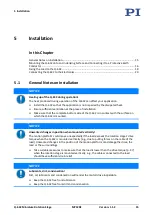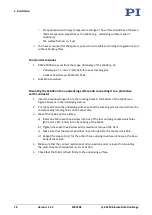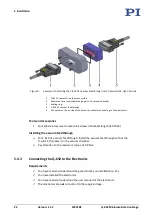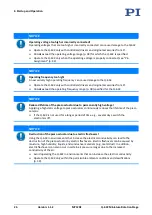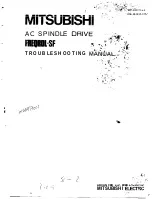
5 Installation
18
Version: 1.1.2
MP129E
Q-632 Miniature Rotation Stage
−
For applications with large temperature changes: The surface should have the same
thermal expansion properties as the Q-632 (e.g., underlying surface made of
aluminum).
−
The surface flatness is
≤
2 µm.
You have accounted for the space required to route cables according to regulations and
without bending them.
Tools and accessories
RPS32.5003 screw set from the scope of delivery of the Q-632 (p. 9):
−
2 dowel pins, 1.5 m6 × 4 ISO 2338; for use as locating pins
−
4 socket head screws, M2×6 ISO 4762
Suitable screwdriver
Mounting the Q-632 onto an underlying surface and connecting it to a protective
earth conductor
1.
Insert the two locating pins into the locating holes in the bottom of the Q-632 (see
figure above) or in the underlying surface.
2.
Put the Q-632 onto the underlying surface so that the locating pins are inserted into the
corresponding locating holes on the other side.
3.
Mount the Q-632 on the surface.
a)
Insert one M2 socket head screw into one of the four outlying countersunk holes
(Ø 2.2 mm / Ø 4.2 mm) in the base body of the Q-632.
b)
Tighten the socket head screw with a maximum torque of 35 Ncm.
c)
Make sure that the screw head does not protrude from the countersunk hole.
d)
Repeat the steps a) to c) for the other three outlying countersunk holes in the base
body of the Q-632.
4.
Make sure that the contact resistance at all connection points relevant for mounting
the protective earth conductor is <0.1
Ω
at 25 A.
5.
Check that the Q-632 is fixed firmly to the underlying surface.












